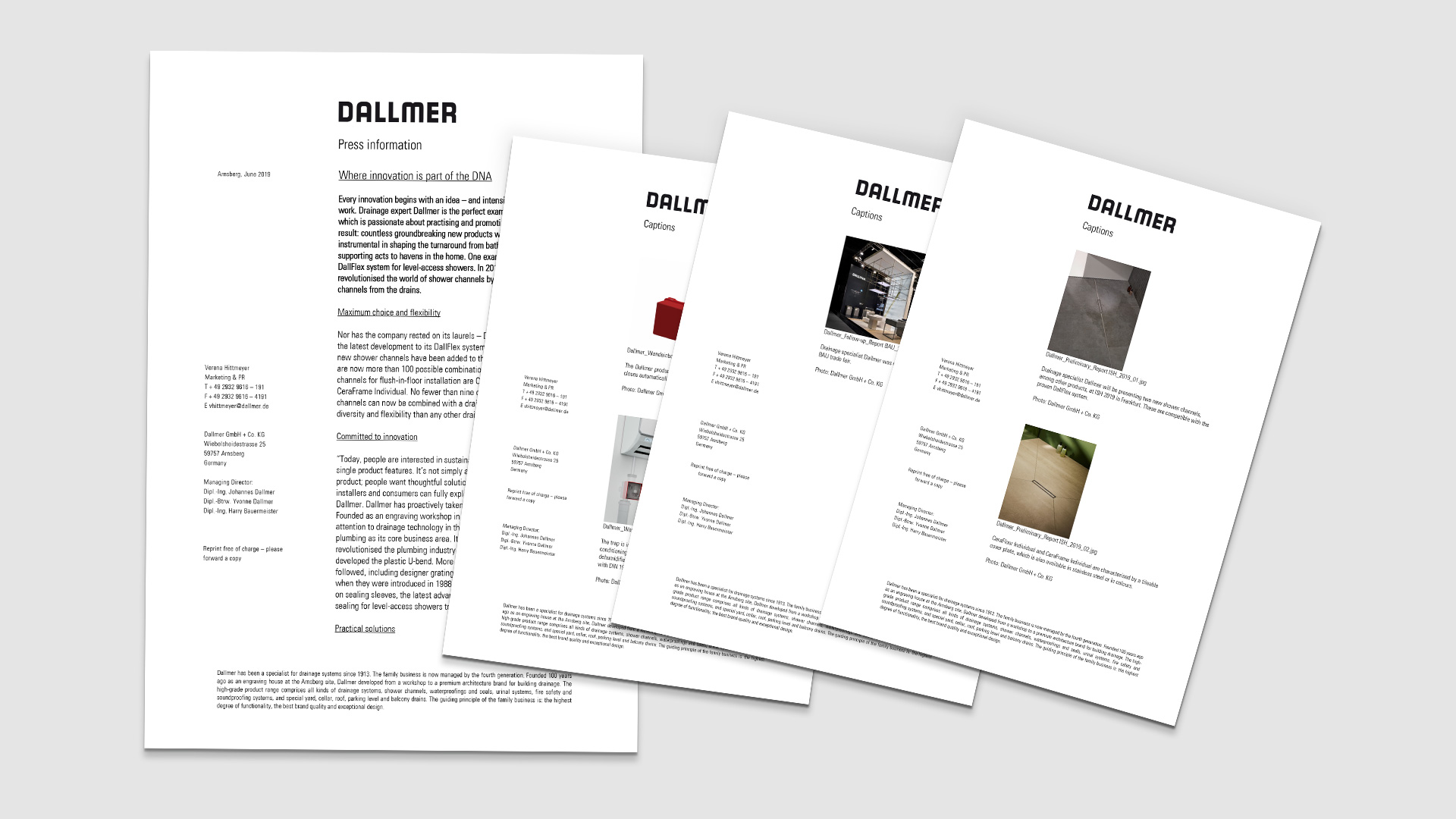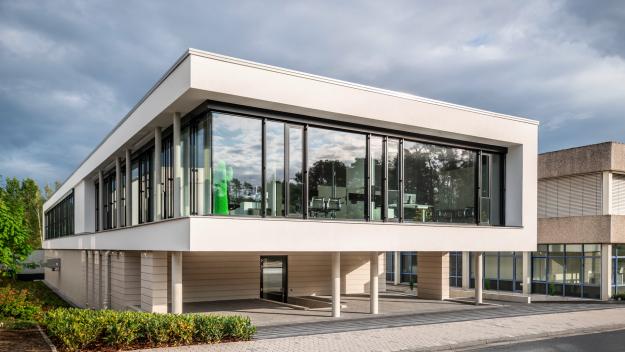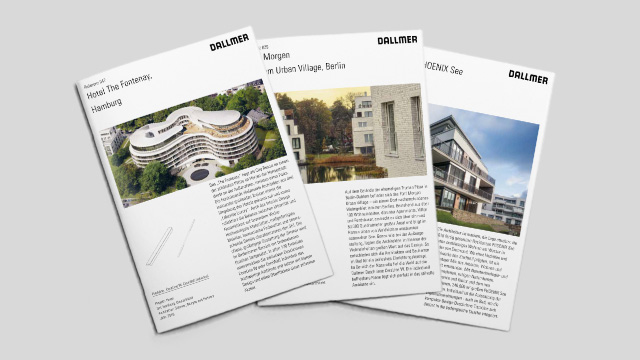Compact knowledge - Fire insulation in construction law
At a glance
- Fire insulation in drainage technology
In preventive fire insulation, floor and roof drains with a vertical outlet are regarded as pipe or ceiling feedthroughs which have to be sealed off so that if fire breaks out, it cannot spread via the drainage pipes. - Minimum requirements for fire insulation
The minimum requirements for fire insulation for pipe systems are documented in the construction ordinances, Technical Construction Rules and the Administrative Regulations for Technical Construction Rules of the individual federal states.
- Preventive fire insulation
Is regulated, for instance, by the MBO, LBOs, DIN EN 12056, DIN 4102 and LAR. - Model Conduit Systems Directive (MLAR)
The MLAR explains how to achieve the safety objectives specified by the Regional Building Code. - Obligatory identification marking and information
Manufacturers of pipe bushings and the companies who carry out the sealing-off of pipes are required to provide proof that the pipe bushings comply with the certificates of usability and to document the conditions in which the implemented pipe bushing functions.
Fire insulation in drainage technology
Within the context of preventive fire insulation, plastic drains with vertical outlets are regarded as pipe/ceiling feedthroughs which require sealing off. This is because if a fire breaks out, flames, smoke and heat can spread very quickly via the wastewater pipes and set fire to further floors of a building. The same applies to flat roofs. In this case, the fire can jump to the roof via the roof drains. In order to prevent this, it must be possible to professionally seal all feedthroughs of this type in compliance with the pertinent standards.
More on the subject of fire insulation: Fire insulation for floor drains and fire insulation for roof drains
Minimum requirements for fire insulation for pipe systems
The minimum requirements for fire insulation for pipe systems are documented in the construction ordinances, Technical Construction Rules and the Administrative Regulations for Technical Construction Rules of the individual federal states.
Current models published by ARGEBAU as the basis for introductions into construction law in the federal states:
- MBO: Model Building Code 2002, last amended in 2016 by resolution of the Conference of Ministers of Construction
- MLAR/LAR: Model directive on fire insulation requirements for pipe systems 2016 (LAR = published version in the federal states)
- MVV TB: Model Administrative Regulation for Technical Construction Rules 2019/-1
Note: Given that the model guidelines are regularly revised, the current version must always be applied.
Preventive fire insulation
Preventive fire insulation when installing floor drains in ceilings with requirements for the fire resistance duration
According to the construction requirements of the Model Building Code MBO §14 "Fire insulation" and the respective definitions of the "fire insulation paragraphs" in the introduced Regional Building Codes for construction, floor drains must be arranged, modified and maintained as a component of the drain pipes so that the outbreak of fire and spread of fire and smoke is prevented, and it is possible to rescue people and animals and carry out effective extinguishing work in case of fire.
Important note: MBO § 14 - Fire insulation
Physical structures must be arranged, erected, modified and maintained so that the outbreak of fire and spread of fire and smoke is prevented, and it is possible to rescue people and animals and carry out effective extinguishing work in case of fire.
Standard requirements and directives for preventive fire insulation
DIN EN 12056
Requirements DIN EN 12056-1 DIN 1986-100
Floor, ceiling and roof drains are always the starting point of any drainage system and are considered an integral part of such a system according to DIN EN 12056 and DIN 1986-100. For that reason, they must also comply with the requirements of the Conduit Systems Directive.
Safety DIN EN 12056-1, Par. 5.4
Drainage systems must be planned and implemented so that reliable protection is provided against:
- the spread of fire ...
Fire insulation DIN EN 12056-1, Par. 5.4.1
In buildings where pipes need to be fed through walls and ceilings that are subject to special requirements in terms of fire resistance, special measures are required according to national and international regulations.
DIN 4102
Fire behaviour of materials and components, material classes DIN 4102-1 / ff
- The fire behaviour of materials, e.g. for pipelines (drains), pipe sleeves, thermal insulation and pipe jackets, is defined by categorisation in set material classes (A1/A2/B1/B2) based on tests carried out according to DIN 4102-1.
- Highly flammable materials must not be used for the field of house technology.
- The basic standard for fire insulation DIN 4102 comprises 18 parts and describes the entire range of fire behaviour of materials and components, and how they are tested. It regulates, for instance, the execution principles of sealing measures, roofing, pipelines and pipe sleeves and the fire behaviour of materials. Given that a component (wall, floor or ceiling construction) comprises multiple individual materials, it is imperative that the individual materials are broken down into non-combustible and combustible. Certification must be provided for the respective categorisation and classification, e.g.:
- Fire trials and testing
- Compilation of a test report
- Issue of a General Building Supervisory Authority Test Certificate (aBP), a General Building Approval (abZ) or a General Design Certificate (aBG)
- By classification in DIN 4102 – Part 4
After completion of a fire trial by an authorised testing institute (e.g. MPA-NRW etc.), the material must be assigned to the respective material class and its usability verifiably documented by an abP, abZ or aBG.
Fire resistance classes DIN 4102-2
When it comes to the fire resistance duration the minimum duration is determined for which the component performs its function when exposed to fire according to DIN 4102-2.
Regional Building Codes
Fire insulation for physical structures according to the Regional Building Codes
Physical structures and their systems and equipment, in particular when taking into account:
- the flammability of the materials,
- the fire resistance duration of the components, expressed in fire resistance classes,
- the leak tightness of the seals on openings,
- the arrangement of escape routes - must have properties which prevent the outbreak of fire and the spread of fire and smoke. Materials which are highly flammable after processing or installation must not be used for the erection or modification of physical structures and other systems and facilities.
Conduit Systems Directive (LAR)
Implementation of line feedthroughs and bushings, LAR (Conduit Systems Directive), section 4
- The Conduit Systems Directive is an essential guideline for the planning and installation of conduits and drains for preventive fire insulation. It has been introduced as construction legislation in almost all federal states. It is thus the implementation ordinance for the federal states. The LAR describes the requirements of conduits, including fastenings and insulating materials, in conjunction with installation in emergency escape routes.
- The LAR aims to improve preventive fire insulation in conduit systems and help all involved in the construction with planning and implementation in order to erect the building to an appropriate and compatible safety standard. It is applied for all building types which are regulated in the Regional Building Codes LBO.
- The LAR defines the execution principles for the penetration of a vertical pipe or a floor/roof drain through a fire-resistant wall/ceiling. In this case, wall and/or ceiling feedthroughs must be in R 30/60/90/120 quality.
- The requirements of the LAR must be met for both non-combustible and combustible drainage pipes.
Classified bushings, LAR, section 4.1
In principle, fire testing based on DIN 4101-1, carried out by an accredited and state-approved material testing centre / a material testing department, is mandatory for classified bushings in R 30 to R 120 quality. Certification of suitability is provided:
- in the form of a General Building Approval (abZ) or a General Design Certificate (aBG) if foaming materials are used to generate the sealing effect in case of fire, or
- in the form of a General Building Supervisory Authority Test Certificate (abP) if the suitability for fire insulation is achieved by the special installation position.
The fire testing is used to certify the maximum permitted surface temperature increase on the side facing the fire. This limitation prevents the spread of secondary fires in case of an outbreak of fire.
On the basis of approvals and test certificates, the planner does not need to define additional constructional measures when using classified bushings for fire resistance classes from R 30 to R 120. This guarantees absolute planning certainty, in particular when it comes to the interfaces of the bushing to the building structure.
Requirements of MLAR 11/2005
Pipeline bushings for open installation systems
Wastewater, rain drainage, floor drains and roof drains
The Conference of Ministers of Construction (ARGEBAU) published the model directive on fire insulation requirements for pipe systems (Model Conduit Systems Directive (MLAR)), issue date 5 April 2016. The MLAR explains how to achieve the safety objectives specified by the Regional Building Code.
Floor drains are construction products which are regulated by European standards and therefore require no further approval for their function. As soon as floor drains contain mechanisms for preventive fire insulation, these floor drains require a General Building Approval (abZ) or a General Design Certificate (aBG), depending on design. When it comes to floor drains after the "relaxations" of the MLAR, adherence to all framework conditions is very difficult and complex. Installation inspection and acceptance is simpler for classified R 30 to R 120 floor drains.
Note: Floor drains are a component of the wastewater system according to DIN EN 12056. For this reason, the identical requirements for sealing off apply as for line feedthroughs. Special mention in the MLAR/LAR is thus not required
Comparison of fire insulation solutions for floor drains
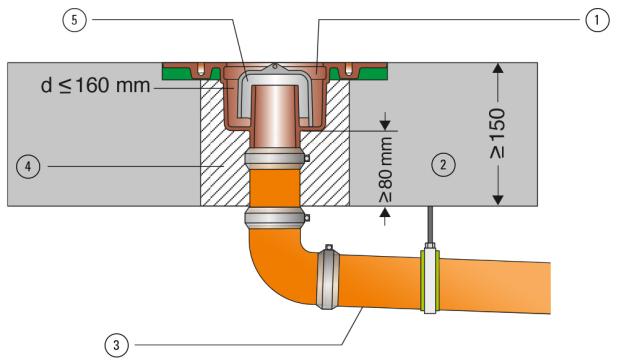
Installation after relaxations
in F 30/60/90 solid ceilings according to MLAR/LAR, section 4.3
- Connection of combustible drainage pipes not permitted
- Specialist planner must prevent secondary fires due to temperature increases (>140 K) using on-site measures
- Floor drain (without fire insulation element) non-combustible
- Concrete surface
- Non-combustible pipe, e.g. SML pipe
- Concrete/mortar MG II/III
- Drain valve non-combustible
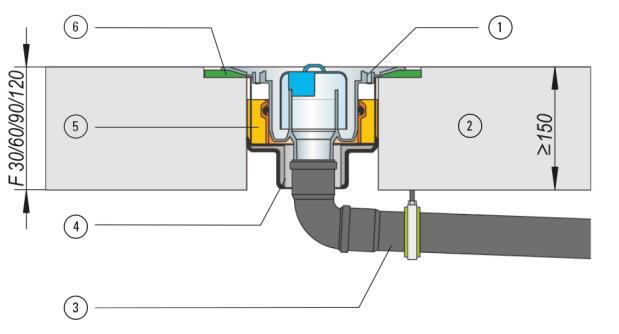
Installation in F 30/60/90/120 solid ceilings with abZ/aBG
(General Building Approval/General Design Certificate)
- Tested system with abZ/aBG
- Exact installation in core drill holes
- No formwork on underside
- No subsequent mortaring from below
- No transmission of structure-borne sound
- Pipe material freely selectable
- Floor drain
- Concrete surface
- e.g. HT pipe
- Dallmer fire insulating structural element
- Mortar MG II/III
- Sound insulation collar
Note: In the case of approved fire insulation systems for floor drains, it is ensured that the temperature increase on the pipe and insulating material surfaces on the side facing away from the fire will not be greater than 180 K in any single measuring point or 140 K as the average value. This reliably prevents secondary fires.
Obligatory identification marking and information
Dimensions of fire insulating structural elements / obligatory identification marking
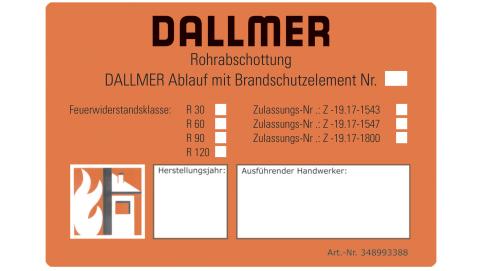
Whenever a pipe bushing is installed, the company implementing it has a duty to inform the client in writing that the pipe bushing only offers effective fire insulation when the trap insert of the drain is filled with water. All pipe bushings must be marked underneath the ceiling feedthrough with a fire safety label in the immediate vicinity of the installation. The marking must be clearly visible.
In accordance with the General Building Approval (abZ) or the General Design Certificate (aBG), the installation technician is supplied with a "Declaration of compliance" form and an information sign with each fire insulating structural element.
With this declaration of compliance, the company that manufactures the pipe bushing confirms that their pipe bushing complies with the provisions of the usability certification (abP/abZ/aBG). This declaration must be submitted to the client or site manager and added to the construction file.
| CERTIFICATE | Bushing with abZ/aBG | Bushing with abP | Feedthrough after "relaxations" |
|---|---|---|---|
|
A) Fire safety label / type plate |
o |
– |
– |
|
B) Declaration of compliance and copy of usability certification |
1x per type and project |
1x per type and project |
– |
|
C) Specialist company certification |
– |
– |
o (recommendation) |
Obligation to provide information: Liability and deviations
Who is liable for fire insulation?
In particular: What is the liability situation in the case of what are referred to as fire safety valves and in case they are lost?
The client / building operator is liable for approved operation, including maintenance, cleaning and the provision of a water trap, from the day of acceptance, e.g. according to VOB-B, § 13 = reverse onus
Deviations in case of General Building Regulation Approval (abZ) or General Design Certificate (aBG)
Deviations from usability certification (abZ/abP/aBG)
When it comes to deviations from the usability certification a distinction is made as follows:
- Non-substantial deviations
In case of non-substantial deviations the tradesperson producing the bushing can submit a confirmation of the non-substantial deviation within the scope of declaration of compliance. According to Regional Arrangements § "Declaration of compliance" a non-substantial deviation is regarded as compliance. If the originator is not certain about the decision, a request should be submitted to the manufacturer, as the owner of the usability certification, for an appraisal. - Substantial deviation
In case of substantial deviations an application must be made to the highest building authority in the respective federal state for an approval for individual circumstances (ZiE) or a project-related design certificate (vGB). The application can be made by a specialist or authorised person with the approval of the client. - Deviations from an Introduced Technical Construction Rule
In the case of floor and roof drains, these kinds of deviations can occur in the context of the Conduit Systems Directives of the federal states. Floor drains based on the "relaxations" are to be cited as an example. The legal basis is based on § 85 (1) of the MBO and the introduced Regional Building Codes of the federal states. The specialist planner of the specific trade must provide certification of equivalent fulfilment of the objective in consultation with the originator of the fire insulation concept. - Deviations from building law
Deviations from building law are also designated as material deviations, e.g. from the regional building ordinances and special building ordinances / directives. Material deviations generally have to be authorised at the lower building authorities, e.g. within the scope of a fire insulation concept or subsequent change. This form of deviation is rare when it comes to floor and roof drains.
Overview of standards and directives
Model Building Code
Is published by the committee of ministers and senators of the 16 federal states responsible for urban development, construction housing (ARGEBAU).
Regional Building Code
The Regional Building Codes (LBO) of the federal states regulate the requirements which have to be adhered to for the building project. All Regional Building Codes are based on the Model Building Code.
Model Conduit Systems Directive, issued by the ARGEBAU, published by the German Institute for Construction Engineering (DIBt)
The MLAR explains how to achieve the (fire) safety targets specified by the Model Building Code. It serves as a guideline for the planning and installation of conduits and drains for preventive fire insulation. The LAR is the issue announced as construction legislation in the respective federal state. The LAR describes the requirements of conduits, including fastenings and insulating materials, in conjunction with installation in emergency escape routes. The LAR aims to improve preventative fire insulation in conduit systems and help all involved to erect buildings to an appropriate and compatible safety standard. The LAR defines the execution principles for the penetration of a vertical pipe or a floor / roof drain through a fire-resistant wall or ceiling. The wall and / or ceiling feedthroughs then have to be implemented in conjunction with national certification of suitability for use (abZ/abP/aBG) in R 30/60/90/120 quality.
Model Administrative Regulation for Technical Construction Rules (MVV TB)
MVV TB represents an important addition to the Regional Building Codes (LBO). The Regional Building Codes regulate planning, dimensioning and implementation of structures and the use of construction products. They also formulate general requirements which are put into concrete terms by MVV TB and clarified with reference to the valid technical rules.
Floor, ceiling and roof drains are always the starting point of any drainage system and are considered an integral part of such a system according to DIN EN 12056 and DIN 1986-100. For that reason, they must also comply with the requirements of the Conduit Systems Directive.
This standard refers to gravity drainage within buildings and specifications, including how drainage systems are to be planned and installed in order to ensure reliable protection against the spreading of fires. In buildings where pipes need to be fed through walls and ceilings that are subject to special requirements in terms of fire resistance, special measures are required according to national and international regulations.
This standard refers to the fire behaviour of components and materials. It defines the fire resistance classes of materials to be used in house technology and how the components and materials are to be tested.
European standard for the fire behaviour classification of building products and building elements. It serves a similar purpose at European level to DIN 4102 at German level.
Construction Tendering and Contract Regulations
The VOB is processed by the German Tendering and Contract Committee and regulates the tendering and contract conditions for construction jobs. It comprises three parts:
- Part A: General provisions for the tendering of building services
- Part B: General contract conditions for the implementation of building services
- Part C: General technical contract conditions for building services
Glossary
Fire insulation includes all measures that contribute towards the prevention and control of fires. Because this is a broad and complex field, different types of fire insulation are divided into the following categories:
- Preventive fire insulation
Concrete measures that contribute towards enabling a fire to be extinguished as quickly as possible and that help save people and animals. - Technical fire insulation
All technical systems that help fire prevention, fire detection and fire suppression – typical examples are smoke detectors, automatic extinguishing systems and smoke and heat extraction systems. - Structural fire insulation
This specifies the materials and components that may be used and how emergency escape routes and extinguishing systems are to be planned. - Organisational fire insulation
Fire officers and company training on the topic of fire insulation fall under the heading of organisational fire insulation. - Defensive fire insulation
All concrete measures aimed at preventing fires and stopping the spread of fires.
As per DIN 4102 and DIN EN 13501, building products are divided into different classes, depending on how long they retain their functionality when exposed to heat.
Downloads
Further downloads
Brochures, references, data sheets, etc. are available in our Download section.
Dated: November 2020
Customer service
+ 49 2932 9616 - 0
Service times:
Monday to Thursday 7:15 - 17:00
Friday 7:15 - 14:00
Contact
Dallmer GmbH + Co. KG
Wiebelsheidestraße 25
59757 Arnsberg
Germany
T. + 49 2932 9616 - 0
F. + 49 2932 9616 - 222
Show address
Contact
Dallmer GmbH + Co. KG
Wiebelsheidestraße 25
59757 Arnsberg
Germany
T. + 49 2932 9616 - 0
F. + 49 2932 9616 - 222










